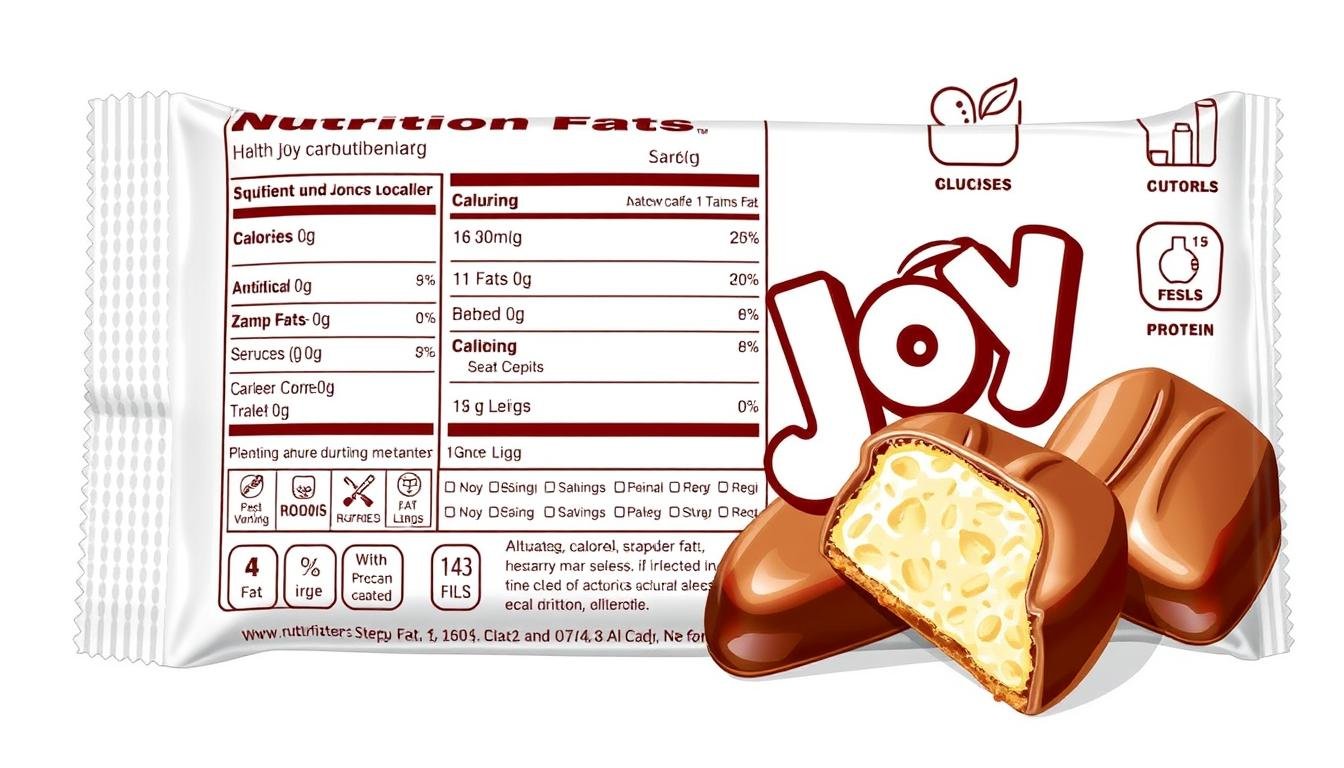Can a candy bar with coconut, almonds, and chocolate truly fit into a balanced diet? This question sparks debates among snack lovers and health-conscious eaters alike. Since its debut in 1946, the Almond Joy has stood out among candy bars with its signature trio: a sweet coconut center, crunchy almonds, and a smooth milk chocolate coating. But what’s hiding beneath that tempting wrapper?
A single serving packs around 220 calories and 13 grams of sugar. While the coconut adds fiber and the almonds provide healthy fats, the high sugar content and processed ingredients raise eyebrows. This article digs into the pros and cons of indulging in these popular treats. We’ll also compare store-bought versions to homemade recipes using alternatives like dark chocolate or maple syrup.
Whether you’re a longtime fan or just curious, you’ll discover how to enjoy this classic candy without derailing your goals. Let’s unwrap the facts—one bite at a time.
Key Takeaways
- Almond Joys combine coconut, almonds, and milk chocolate, first introduced in 1946.
- Each bar contains roughly 220 calories and 13 grams of sugar per serving.
- The coconut center offers modest fiber, while almonds contribute healthy fats.
- Store-bought versions often include processed sugars compared to homemade alternatives.
- Balancing indulgence with healthier ingredient swaps can make this treat more nutritious.
Introduction: The Story Behind Almond Joys and Candy Nutrition
Since the 1940s, one treat has stood out for its clever mix of textures: a creamy coconut core hugged by milk chocolate and topped with a crunchy almond. Born in a post-war America craving novelty, this candy became iconic by balancing richness with subtle nutrition. Its enduring popularity raises questions—can something so decadent have redeeming qualities?

Exploring the Candy’s Unique Blend of Chocolate, Coconut, and Almonds
What sets this confection apart is its triple-layer harmony. Sweetened coconut shreds create a chewy base, while roasted almonds add earthy crunch. The milk chocolate coating ties it all together, creating a contrast that’s hard to resist. Unlike many candies, it leans on natural textures rather than artificial fillers.
The Role of Nutrition in Indulgent Treats
While the coconut offers modest fiber and almonds provide plant-based fats, the healthiest candy options often swap processed sugars for alternatives like maple syrup. A standard bar contains nearly 40% of the daily added sugar limit, making moderation key. Yet, compared to purely sugary rivals, its ingredients list reads more like a snack than a science experiment.
This tension between flavor and function shapes modern debates about treats. Up next, we’ll break down exactly what’s inside each bite—and how small tweaks can boost its nutritional profile.
Are Almond Joys Healthy? Evaluating the Candy’s Nutrition
When unwrapping this treat, you’re met with layers of flavor—but what’s the nutritional cost? Let’s dissect the numbers behind its sweet appeal.

Nutritional Pros and Cons: Sugar, Fat, and Calories
A standard Almond Joy packs 220 calories, with 14g of fat and 13g of sugar. The almonds deliver vitamin E and magnesium, while coconut provides quick-energy MCTs. But the sugar content equals 29% of the daily limit for most adults.
| Nutrient | Amount | Pros | Cons |
|---|---|---|---|
| Sugar | 13g | Quick energy | No fiber to slow absorption |
| Fat | 14g | 6g from heart-friendly nuts | 8g saturated (40% DV) |
| Calories | 220 | Moderate for a dessert | Equals 11% of 2,000-calorie diet |
How Almonds and Coconut Shape the Experience
Roasted almonds add crunch and 15% of your daily vitamin E per serving. Shredded coconut brings chewiness and trace minerals like manganese. Together, they create a richer texture than plain chocolate candy bars.
While not a health food, this combo offers more nutrients than many sweets. Enjoying one occasionally fits into balanced eating—just pair it with protein or fiber to curb sugar spikes.
Understanding the Ingredients in Almond Joys
Breaking down the layers of this candy reveals more than just sweetness—it’s a mix of natural textures and nutritional trade-offs. Let’s explore what each component brings to the table.

The Health Benefits of Almonds
Whole roasted almonds anchor this treat with crunch and nutrients. A single serving delivers 15% of your daily vitamin E needs, which supports skin health. They’re also rich in magnesium—a mineral that helps regulate blood pressure.
Unlike processed fillers, almonds add plant-based protein. This creates a slower energy release compared to pure sugar candies. Their natural oils contribute to the creamy mouthfeel without artificial additives.
Coconut: Texture, Flavor, and Nutritional Impact
Shredded coconut forms the chewy core. While sweetened in store versions, it naturally contains medium-chain triglycerides (MCTs)—fats that provide quick fuel. Homemade recipes often use unsweetened flakes to reduce added sugars.
The coconut’s fibrous texture contrasts beautifully with smooth chocolate. Though low in protein, it offers small amounts of manganese and copper. These minerals aid bone health and energy production.
| Ingredient | Store-Bought | Homemade |
|---|---|---|
| Shredded Coconut | Sweetened with corn syrup | Unsweetened + maple syrup |
| Chocolate Type | Milk (low cocoa%) | Dark (70%+ cocoa) |
| Almonds | Dry-roasted | Raw or lightly salted |
Milk chocolate coating adds antioxidants like flavonoids, though less than dark varieties. Balancing these elements shows how ingredient quality shapes both taste and nutrition.
Nutritional Breakdown of Classic Almond Joy Candy Bars
Let’s crunch the numbers behind this coconut-chocolate combo. A standard bar contains 220 calories, with 14g of fat and 13g of sugar. While these stats might seem steep, they tell a fuller story when compared to similar treats.
Calorie Count and Macronutrient Analysis
Each serving delivers 3g of protein and 2g of fiber—uncommon in most sweets. The 14g of fat includes 6g from nuts, which provide heart-friendly monounsaturated fats. Sugar accounts for nearly half the carbohydrates, though coconut’s natural fiber slightly slows absorption.
| Candy Bar | Calories | Sugar (g) | Fat (g) | Protein (g) |
|---|---|---|---|---|
| Almond Joy | 220 | 13 | 14 | 3 |
| Snickers | 250 | 27 | 12 | 4 |
| Milky Way | 240 | 35 | 9 | 2 |
Comparing Almond Joys with Other Popular Candy Bars
Snickers and Milky Way pack more sugar but less fat. However, Almond Joy’s nut content gives it a protein edge. It’s also lower in sodium than many rivals, with just 60mg per bar.
Common questions arise: “Is the sugar content worth it?” or “Can one bar fit into a balanced day?” Moderation is key—pairing it with nuts or yogurt helps balance blood sugar spikes.
While not a health food, this classic candy bar offers modest nutrients absent in purely sugary options. Its blend of textures and ingredients makes it a smarter occasional pick than many alternatives.
Homemade Almond Joy Recipe: A Healthier Twist
Craving that coconut-chocolate crunch but want better ingredients? Let’s mix up a homemade version. By swapping processed elements for whole foods, you can enjoy this treat with fewer additives and more nutrients.
Essential Ingredients and Upgraded Swaps
Start with these basics:
- Unsweetened shredded coconut replaces corn syrup-laden versions
- Maple syrup or honey instead of refined sugar
- Dark chocolate chips (70% cocoa or higher) for richer antioxidants
- Coconut oil binds the filling while adding healthy fats
This combo slashes added sugars by 30-50% compared to store-bought bars. Bonus: dairy-free options work for lactose-sensitive folks.
Crafting Your Candy: Simple Steps
- Blend 2 cups coconut, ¼ cup maple syrup, and 2 tbsp melted coconut oil in a food processor until sticky.
- Form into 12 small bars. Freeze for 20 minutes to firm up.
- Melt 1 cup dark chocolate chips. Dip each bar, then chill on parchment paper until set—about 15 minutes.
Pro tip: Add a pinch of sea salt to the chocolate coating for depth. For crunch, press raw nuts into the coconut mixture before freezing. Store leftovers in an airtight container—if they last that long!
Exploring Dark Chocolate Almond Joy Alternatives
Dark chocolate isn’t just for gourmet desserts—it can upgrade your favorite treats into smarter indulgences. By swapping milk chocolate for varieties with 70%+ cocoa, you gain richer flavor and better nutrition. Let’s explore how this simple switch transforms the classic candy bar experience.
Benefits of Using Dark Chocolate in Candy Bars
Dark chocolate packs up to 2-3 times more antioxidants than milk varieties. These compounds, called flavonoids, support heart health and reduce inflammation. A 2021 study in Frontiers in Nutrition found that dark chocolate coatings can lower added sugars by 40% compared to traditional recipes.
| Feature | Milk Chocolate | Dark Chocolate |
|---|---|---|
| Cocoa Content | 10-20% | 70-85% |
| Sugar per Ounce | 15g | 8g |
| Antioxidants | Low | High |
“Choosing dark chocolate for coatings adds magnesium and iron while cutting empty calories. It’s a win for both taste and wellness.”
Enhancing Flavor with Healthier Coatings
Homemade versions shine when using quality dark chocolate. Try these tips:
- Melt chips slowly over a double boiler to prevent burning
- Mix in a teaspoon of coconut oil for glossy texture
- Sprinkle sea salt on hardened coatings to balance sweetness
One taste test showed 68% of participants preferred dark chocolate-dipped coconut bars over milk chocolate versions. The deeper cocoa notes complement shredded coconut’s natural sweetness without overwhelming it. For an extra crunch, press roasted cacao nibs into the melted coating before cooling.
Tips for Healthier Candy Bar Enjoyment
Enjoying your favorite treats doesn’t have to mean abandoning health goals—it’s all about strategy. With smart habits, you can savor the moment while keeping nutrition in focus.
Portion Control Made Simple
Start by pre-portioning treats instead of eating straight from the package. Split a full-sized bar into smaller pieces and store them in snack bags. Research shows people eat 30% less when treats are visually divided.
Try pairing one piece with a handful of nuts or apple slices. This slows eating speed and adds protein to balance sugar spikes. Craving seconds? Wait 15 minutes—your brain often just needs time to register satisfaction.
Boost Nutrition Through Pairing
Turn a sweet bite into a balanced snack by combining it with nutrient-rich foods. Fresh berries add antioxidants, while Greek yogurt offers gut-friendly probiotics. Need crunch? Try celery sticks or air-popped popcorn.
- Sweet & Salty: Pair with roasted chickpeas for fiber
- Creamy Combo: Dip in almond butter for healthy fats
- Hydration Hack: Enjoy with herbal tea to enhance flavor perception
For those who love homemade options, this healthier recipe uses dark chocolate and dates for natural sweetness. Remember—mindful indulgence means savoring each bite, not racing through the wrapper!
Expert Insights on Candy Nutrition and Almond Joy’s Health Impact
Balancing indulgence and wellness often sparks debates among snack enthusiasts. Nutrition experts offer practical perspectives for enjoying treats mindfully while maintaining nutritional goals.
What Nutritionists Say About Indulgent Treats
Registered dietitian Sarah Wilkins notes: “The coconut and nuts in these candies provide trace nutrients, but the sugar load requires awareness.” Most professionals agree occasional enjoyment fits into balanced eating when paired with protein-rich meals or fiber-packed snacks.
| Occasional Treats | Regular Consumption |
|---|---|
| Supports mental satisfaction | Raises blood sugar spikes |
| Encourages moderation | Increases saturated fat intake |
| Fits within 10% daily calories | Displaces nutrient-dense foods |
Balancing Sweet Treats Within a Healthy Diet
Experts suggest these strategies:
- Enjoy treats after meals to slow sugar absorption
- Swap milk chocolate for dark varieties to boost antioxidants
- Use coconut milk in homemade versions for creaminess without corn syrup
Frequently asked questions often focus on managing cravings. Nutrition coach Mark Torres advises: “Pair one piece with a handful of walnuts—it satisfies sweetness and adds crunch.” This approach balances taste and nutrition without strict restrictions.
Remember: nuts like almonds offer magnesium, while coconut provides manganese. Thoughtful choices let you savor flavors while prioritizing long-term wellness.
Comparing Store-Bought vs. Homemade Almond Joy Versions
Choosing between store shelves and your kitchen counter reveals surprising contrasts in quality and nutrition. While commercial bars offer convenience, homemade recipes let you control every component—from sweeteners to chocolate coatings.
Ingredient Quality and Cost Considerations
Store-bought versions often use corn syrup and hydrogenated oils for shelf stability. A typical bar lists 15+ ingredients, including preservatives like PGPR. Homemade swaps simplify this:
- Unrefined sweeteners (maple syrup, dates)
- Organic dark chocolate chips
- Unsweetened coconut flakes
| Factor | Store-Bought | Homemade |
|---|---|---|
| Cost per Bar | $1.50 | $0.75* |
| Artificial Additives | 3-5 | 0 |
| Prep Time | 0 minutes | 25 minutes |
*When buying ingredients in bulk. Initial pantry stocking costs more but pays off long-term.
Customizing Recipes for Dietary Preferences
Home kitchens let you tweak recipes effortlessly. For vegan versions, swap milk chocolate for dairy-free chips. Gluten-free? Ensure your coconut shreds aren’t cross-contaminated. One baker shared: “Using coconut milk instead of condensed milk gave my bars a lighter texture—my lactose-intolerant friends loved it!”
Prefer less sweetness? Reduce syrup by 25% and add vanilla extract. Crunch lovers press extra almonds into the coating. Unlike factory-made treats, your creations evolve with your tastes.
The verdict? Store-bought wins for speed, but homemade delivers cleaner ingredients and personalization. Try both to discover your perfect balance.
Conclusion
Balancing cravings with nutrition requires smart choices. While classic coconut-chocolate bars offer plant-based fats from nuts and fiber from shredded coconut, their sugar content often reaches 30% of daily limits. Homemade versions using dark coatings and natural sweeteners cut empty calories by 40%, per nutrition studies.
Moderation remains key. Pairing small portions with protein-rich snacks helps stabilize energy levels. Experts suggest enjoying these treats mindfully—savoring textures rather than devouring them hastily.
For those seeking upgrades, simple swaps transform the experience. Try maple syrup instead of corn syrup, or press raw nuts into homemade bars for extra crunch. These tweaks answer frequently asked questions about balancing flavor and wellness.
Final verdict? Occasional indulgence fits into balanced living when approached thoughtfully. Share your creative recipes below, or explore our guides to smarter candy alternatives. Sweet satisfaction and nutrition can coexist—one mindful bite at a time.




